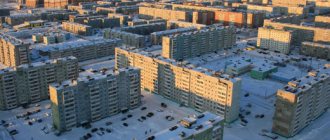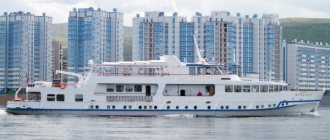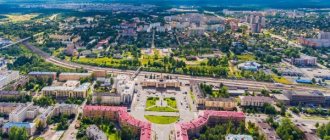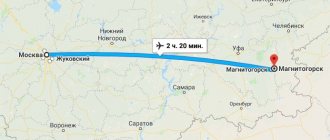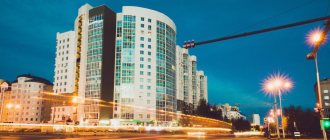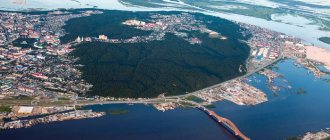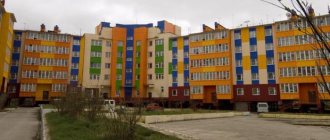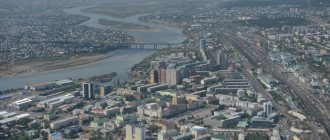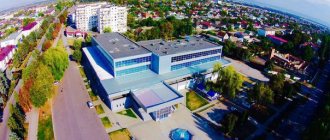Kuban is the largest river in the North Caucasus. The Bolshoy Zelenchuk River flows into it. A large cape formed at the confluence. It was on it that Nevinnomyssk was founded. This situation is reflected in the city coat of arms - two blue stripes converge on a golden field, forming a green triangle. The city is the starting point for many tourist routes in the North Caucasus.
Coat of arms of Nevinnomyssk
Nevinnomyssk on the map
Nevinnomyssk is located in the Ciscaucasia region on an elevated part of the Stavropol Territory, along the banks of the calm Kuban River, which merges with a watercourse called Bolshoi Zelenchuk. The city is located 55 km from Stavropol at an altitude of 343 m above sea level. m.
It covers an area of more than 100 km2. The settlement received its name thanks to the Nevinka River, which flows near the station. Ust-Nevinka.
Despite its small territory, Nevinnomyssk is divided into the following districts:
- PRP;
- Center;
- Head;
- spare parts;
- Red Village;
- MZHK;
- Old city;
- Comet;
- Mill;
- Pravokubansky;
- Rozhdestvenka;
- House of Life;
- Factory.
The city has moderate continental climatic conditions. Winters here are long and mild with average January temperatures of 80 C. Summers are fleeting and hot. The average July temperature is +160 C.
On the Innocent Cape
The city of Nevinnomyssk is located in the Ciscaucasia, 70 kilometers south of Stavropol. From a geographical point of view, the area is called the Stavropol Upland. Urban development stretches along the left bank of the Bolshoi Zelenchuk River and the right bank of the Kuban River. The internal floodplain area between the rivers is not built up and is a forested area. This is a favorite vacation spot for city residents.
There are two main versions regarding the history of the origin of the city's name. The first belongs to the military historian Vasily Potto. More than a hundred years ago, he studied the Mozdok archive and discovered a circular dated 1784. It followed from it that the river flowing into the Kuban was ordered to be called Innocent. It already had a name given by the soldiers, but it sounded obscene. Later, a village was founded on the cape, at the confluence of the Nevinnaya River and the Kuban. The name Nevinnomyssk was assigned to it.
The author of the second version is the Stavropol local historian V. Kolesnikov, who wrote the book “The Past of the Innocent Cape”. In his opinion, the name of the settlement was given by Count Pavel Potemkin in 1784. The reason was the nearby mountain "Aryuv-kyz". Translated from Nogai it means “beautiful girl”. There is a legend associated with the mountain, according to which an innocent girl died after being married to an unloved man.
Steles framing the city
Steles rise on both sides of the city:
- One of them stands at the entrance to the village from the Stavropol direction. The monument is a stone structure, in the lower part of which the name of the city is written, and on one side of the monument there is a high pillar.
- Another memorial plaque is located at the entrance to the settlement on the side of Mineralnye Vody. It is dedicated to workers in the energy industry and the production of energy. The stele was installed on the street. Power engineers, not far from the hydroelectric power station.
A monument in the form of a male figure was erected nearby in 2008. In one of his palms lies a gear with outgoing energy radiation, and in the other he holds the sun. The man's face is turned to the sky. The monument is made of stainless steel and covered with silver paint.
The statue stands on a high pedestal, on which the word “GRES” is written in huge font.
Museum of Local Lore
The city museum of local lore was founded in 1957 as the “Exhibition of Military Glory.” A collection of 500 items was assembled as exhibits. Eight years later, by decision of the city authorities, the exhibition was transformed into a museum of labor, military and revolutionary glory.
Since the end of the twentieth century. The institution is an independent staff structure under the Culture Committee and is called the Nevinnomyssk Local Lore and History Museum. In the same year, he was moved to a separate modern building located in a residential area of the central part of the city on the street. Gagarina 43b.
Nevinnomyssk has a rich history, which can be found in the city local history museum
There are several halls here:
- Expositional, telling about the history of the city, from its first inhabitants to the present day.
- An exhibition hall, distinguished by the fact that it has monthly changing expositions of different directions. Often exhibitions are placed in the building's lobby.
- Here they constantly conduct excursions and give lectures for city schoolchildren, students and military people.
For the exhibition dedicated to the Second World War, many new exhibition complexes were created in the historical hall. Currently, the museum collection includes about 12.3 thousand items. The institution's funds are constantly replenished thanks to local residents. The museum is open to visitors every day from 9.00 to 17.00, except Mon.
An adult entrance ticket costs 5 rubles, and for a child ticket you need to pay 2 rubles.
Story
The ancient history of Nevinnomyssk begins in the first millennium AD. A section of the Great Silk Road ran through the territory. Here were the settlements of the Scythians and Khazars.
In the 18th century, the fighting of the Russian-Turkish War took place. Later, battles were fought with the Circassians. Then the defensive line appeared.
On October 14, 1825, the village of Nevinnomyssk was founded. Soon it was filled with the Armed Forces of the Russian Empire. In 1875 the railway was built. Production began to develop: the largest mill and textile factory were launched. There were schools and religious institutions.
At the beginning of the 20th century, there were protests by workers and residents. Soviet power was established in 1918. On October 19, 1939, city status was received. During the Second World War, the settlement was occupied. After its completion, it was restored and enterprises were erected in it. As part of the Russian Federation, the pace of development has slowed down.
Monuments to the Cossacks
Nevinnomyssk is located in a historical area that was conquered by people at the cost of their own lives. In 2012, not far from the mass grave on the street. Revolutionary, 18, a monument to the founding Cossacks was unveiled in an official setting.
Don't miss the most popular article in the section: Metro Nizhny Novgorod. Diagram, map, description.
The sculptural complex is dedicated to the local Cossacks, who protected Art. Nevinnomysskaya in 1842 and died heroically. The monument is a massive block in the form of a worship cross, installed on a marble platform. The sculpture is topped with a steel cross.
The names of 17 dead Khoper residents are carved on the stone.
Stele on Belovo street
This example of unity not only of Russian lands, but also neighboring ones, was built in honor of the Bulgarian city - Belovo's sister city, after which the street was named. The stela was installed in a small park, which was previously a place for celebrations of Soviet youth. In addition, there is a monument to the Hero of the Soviet Union T.N. Podgorny and a memorial dedicated to the townspeople who died while eliminating the consequences of the accident at the Chernobyl nuclear power plant.
Monument to the 85mm anti-aircraft gun
The grand opening of the monument to the Anti-Aircraft Cannon took place in 1981. The Obelisk was placed on Mira Blvd. It looks like an 85mm anti-aircraft gun standing on a low cast iron platform. The pedestal is made in the form of a rectangular figure, one edge of which is higher than the other.
Due to this circumstance, the cannon is directed upward, which indicates its main purpose - to destroy as many enemy aircraft as possible. The sculptural composition reminds local residents of the hot summer of 1942, when soldiers of the 18th Artillery Division, at the cost of their own lives, recaptured their hometown from the Nazis.
Cathedral of the Intercession of the Blessed Virgin Mary
The Church of the Intercession of the Blessed Virgin Mary is considered the largest church community in the Stavropol diocese. At the same time, it can accommodate about 1.5 thousand parishioners. At the turn of the 20th and 21st centuries. the temple was elevated to the rank of a cathedral. The village of Nevinnomyssk was founded on the day of the Intercession of the Mother of God, and a holy place was also founded with the name Pokrovsky.
The old church stood in the middle of the settlement, but after the revolution it was destroyed. On the 100th anniversary of the Baptism of Rus', it was decided to build a new temple in Nevinnomyssk. A competition was announced for the best design for the future cathedral. As a result, they chose the project of S. Rudik. Construction lasted for 10 years.
In 1992, on Easter, the first service was held in the still unfinished building. The church was built in the form of a five-domed quadrangle, the front facade of which is decorated with risalits. In the western part of the temple there is a bell tower. The cathedral is located on the street. Apanasenko 1b. It has 2 thrones, one of them is consecrated in honor of Equal-to-the-Apostles Vladimir.
Services in the cathedral are held according to the year-round cycle of services.
Population before revolutionary times
Four years after the founding of the village of Nevinnomysskaya, 1,498 people lived in it. By 1844, the population of Nevinnomyssk reached 2025 people. This was primarily due to the resettlement of the Khoper and Volga Cossacks for protection from abrek raids. In subsequent years, the number of residents grew due to natural growth. The number of inhabitants increased rapidly in the last decade of the 19th century, reaching 8,371 in 1897. By this time, it was possible to eliminate the raids of the warlike highlanders, a railway was built, and the first factories were built. The population of Nevinnomyssk increased due to the influx of people from the central regions of Russia. In the last year before the First World War, 15,293 people already lived in the village. Two years later, in 1915, the population had dropped to 13,057. The majority of the male Cossack population was sent to fight.
Peter and Paul Church
In Nevinnomyssk on the street. Nizyaev, not far from the main entrance to the Nevinnomyssky Azot plant, there is a medium-sized log church, consecrated in honor of the Supreme Apostles Peter and Paul. The church building was built in 2006, with money donated by the Azot enterprise and with personal funds from the leaders of the enterprise.
The structure was erected using the ancient technique of Russian felling.
Calibrated coniferous boards were specially brought for construction. Construction work was carried out over 4 months. The parish is designed for 150 believers. The temple has its own tradition - local Cossacks take the oath there. In 2010, a rector was appointed to a permanent place of service in the parish. Before this, different priests served here according to schedule.
Military bunker near the railway bridge
Nevinnomyssk is located in an area where battles took place during the Second World War, and therefore has memorial objects dedicated to this period. The monument to the bunker (long-term firing point) was erected in 1985 on the right bank of the river. Kuban near the railway pontoon.
The bunker began to exist as a defensive structure in 1942, and at present it is the only firing point that has been preserved since the Second World War on the territory of the Stavropol region. In mid-1942, the fascist invaders broke through our defenses and began moving to the Caucasus.
A small NKVD unit, numbering 36 people, was given the task of holding the enemy attack, and if they had to retreat, then blow up the pontoon. The soldiers fought bravely, but without waiting for the command to retreat, they died. They were buried in a mass grave in a village called Golovnoye. The bunker was restored during Soviet times.
For the 40th anniversary of the Victory in the Second World War, a monument was erected with a pentagonal memorial plate on which the names of the fallen soldiers are engraved.
Theaters
Theatrical performances in Nevinnomyssk are held monthly in the following institutions:
| Location of the performance | Address |
| MBUK House of Culture "Sherstyanik" | st. Mayakovsky, 24 |
| MBU "Central Library" | Mira Blvd., 16a |
| "City Palace of Culture named after. Gorky" | st. Mendeleeva, 25 |
| Puppet theater "Teremok" | st. Kalinina, 186 |
| Leisure complex "Rodina" | st. Lenina, 85a |
Parks of Nevinnomyssk
For relaxation and walks in Nevinnomyssk there are the following green areas:
The Factory Park or “Sherstyanik” got its name due to the fact that there is a wool washing plant nearby. It appeared in the middle of the 19th century. thanks to the merchant Lapin, who was the owner of this factory. The park area is located in the city district of the same name on the street. Mayakovsky, 24. Visitors can get here every day from 6.00 to 23.00.
This place is popular among city residents. Some trees have been growing for several centuries. Various animal figures are installed throughout the park area, and there is a gazebo near the pond. There are several monuments in the central part of the park.
The river flows nearby. Big Zelenchuk.
Green Island. In its space there is a figure of a decorative horse, and wooden pillars remain from the buildings. Old poplars grow along the paths and apple trees are clustered. The city authorities plan to establish a tourist and recreational zone in this place. A modern concrete structure will stand in the area of the remains of the old bridge.
Park of Culture and Recreation
Nevinnomyssk is located in the industrial zone of the Stavropol Territory. Despite this, the city has natural spots. One of them, the City Park of Culture and Recreation, extends near the Khimikov Palace of Culture on the street. Pavlova, 1 and is the main natural monument of this region.
Video showing the city from a bird's eye view:
Many varieties of rare plants grow on its territory. A unique place in the city park is the chestnut alley, when planting it the latest technologies were used, providing for the fusion of 2 or 3 seedlings. The park area, covering an area of 12 hectares, is also decorated with several decorative ponds. In summer, holidays and special events are held here.
The park has a large number of attractions, their cost varies between 100-400 rubles. It also houses the city's largest entertainment complex called the Pier. On the other side of the Khimik Palace of Culture there is a small go-kart track.
Price for 10 min. skating costs 100 rubles.
Population in modern times
In the first post-revolutionary years, the population of Nevinnomyssk experienced civil war, repression, famine and collectivization. On the collective farm. Lenin, organized in the village in 1939, had a population of 23,600 people. In the post-war years, the population began to grow rapidly due to the influx of people from other regions of the country to construction sites and industrial enterprises. In 1959, the population of Nevinnomyssk was 39,806 people. In 1970, the number of inhabitants exceeded 80 thousand for the first time (85,067).
Construction and reaching the design capacity of the chemical plant required attracting labor resources from other Russian regions. In 1975, the number of city residents reached 100,000 for the first time. The population continued to increase even in the difficult 90s until 1998, when the number reached 133,802 residents. In the 21st century, the population of Nevinnomyssk is gradually decreasing, with the exception of 2015-2016, when there was a slight increase. According to the latest data from 2022, the city has 117,446 inhabitants. The main population by national composition: the majority are Russians - 89.90%, followed by Ukrainians - 1.99%, Armenians - 1.84%.
Boulevard of Peace, fountain
The fountain located on Mira Boulevard is considered one of the best cascades in the Stavropol Territory. This man-made reservoir was installed recently, but it immediately gained great popularity among citizens and guests of the city. The water structure functions only in spring and summer and relieves people from the sweltering heat.
The area around the cascade was paved with luxurious tiles, which brings sophistication and charm to it. Everywhere there are benches, elegant lanterns and flower beds decorated with flowers.
Center
The main part of the city is located on the right bank of the Kuban River and, interestingly, has a controversial center according to local residents. When I arrived in Nevinnomyssk, I was immediately told that the center of the city should be considered the place where the administration is located: the large beautiful building of Sberbank, the Central Department Store and a number of shopping and business complexes.
But as soon as I settled near the Boulevard of Peace, my new neighbors began to impose a completely different opinion. They say they have the city center. And these arguments are more like the truth, because the Boulevard of Peace is a beautiful pedestrian street, one end abuts the wedding palace under construction, and the other ends in the square in front of the Palace of Culture of Chemists, where celebrations of the city day, May 9 and many other celebrations are held.
Next to the Palace of Culture there is a central park where you can have a good time. I often go here with my children.
How to get there
Getting to the center will not be difficult. From the bus station to the stop “20 school” or “hotel “Kuban”” you can take bus No. 15, and if you arrived in the city by train, then from the railway station you can get to the center by taxi standing nearby (the trip will cost approximately 50- 60 rubles). Previously, there were shuttle buses from the railway station, but now there are clearly some problems with this.
Where to go
Since this area is practically the heart of the city, there is plenty to do here.
You need to start your acquaintance with Nevinnomyssk from Mira Boulevard, a pedestrian street. There are several memorials dedicated to the Great Patriotic War on it; the Eternal Flame burns near the stele and there is an anti-aircraft gun of those years.
On the boulevard there is the central city fountain, near which many citizens walk on hot summer days.
Opposite the fountain is the building of the Mir cinema (tickets for screenings cost from 100 to 200 rubles).
If you get hungry, you can go to the following places:
- “Burrito Boom” is a cafe with Mexican cuisine. Located on Mira Boulevard, 2. Average bill is 350-500 rubles.
- Pizzeria “Leto” is a cafe with European cuisine on Mendeleev Street, 24. Lunch here will cost you 350-1500 rubles.
- Fast food restaurant "SubWay" - st. Mendeleeva, 24. Here you can have a fast food snack. The average check here is about 100-250 rubles.
- Bar “Petrovich” - Mendeleev St., 16. European cuisine, lunch price 1500-2500 rubles.
- Cafe "Kubanochka" - Belovo St., 3. European cuisine. The interior of the cafe is made in the spirit of the Cossack Kuban. The average bill is 1000-1500 rubles.
A little further, near the Palace of Culture of Chemists, there is the central park of Nevinnomyssk. There are many attractions there: from a train for kids to a Ferris wheel. On average, the cost of attractions for one session is 200-400 rubles. From the park you can go straight to the embankment of the Kuban River.
Where to stay
If you rent housing in the city center, then renting an apartment for a day will cost 1000-1500 rubles. I was looking for an apartment on Avito, where you can find the best option that suits you. True, on the street. Mendeleeva, 16 there is a hotel “Kuban”, where the cheapest room costs from 900 rubles. There, in the basement, guests are fed in the Adrenaline cafe (300-500 rubles).
Interesting Facts
Nevinnomyssk, located in a picturesque area, has the following interesting facts:
- The city was under German occupation for 6 months, which is why it has a large number of monuments dedicated to the heroes of the Second World War.
- Land was brought to the settlement from places where large-scale battles took place: the Field of Mars, Mamayev Kurgan and the Brest Fortress.
- Nevinnomyssk became famous for its brave fellow countrymen. This is Art. Lieutenant Gusev and gunner T. Podgorny, who destroyed many German tanks. Monuments to them were erected here.
- Archaeological facts indicate that nomadic herders lived in this area thousands of years ago. Sarmatian, Khazar and Scythian burials were also discovered in the surrounding lands.
- In the middle of the 20th century. Construction of a plant for the production of nitrogenous fertilizers began in Nevinnomyssk. This circumstance marked the beginning of the chemical industry. Currently, the Azot plant occupies about 10% of the city's territory. It is separated from residential areas by a wide forest belt.
The city of Nevinnomyssk gives all its residents the opportunity to enjoy the splendor of wild nature, because it is located at the confluence of two waterways. Despite its young age, there is something for tourists to see here.
Article design: E. Chaikina
Kingdom of water and greenery
Summers in Nevinnomyssk are hot and winters are mild. This climate is called temperate continental. Since there is a lot of water and heat here, the surroundings of the city are surrounded by greenery. The most precipitation falls in May, June and August. The least is in January and February. The hottest period is July-August. The air at this time warms up to +28 degrees. It is coldest from December to February, but the cold here is conditional, since the temperature fluctuates around zero. In the coldest years it did not fall below -7 degrees.
City outskirts
The city is crossed by two waterways - Kuban and Bolshoy Zelenchuk. The length of Kuban reaches 870 kilometers! It originates on Elbrus in Karachay-Cherkessia and carries its waters to the Sea of Azov. It’s hard to believe, but along its entire length, 14 thousand large, small and very small tributaries flow into the river! It is curious that after Nevinnomyssk the right tributaries completely disappear. The width of the river in the urban area reaches from 50 to 100 meters. There are several large islands in the channel. The largest has dimensions of 1800x500 meters.
The Bolshoi Zelenchuk River is significantly inferior to the Kuban. Its length is only 158 kilometers. It originates near the village of Arkhyz and flows into the Kuban in Nevinnomyssk. In the upper reaches, along the left bank, stretches the Teberda Nature Reserve. On the river there is the Zelenchukskaya hydroelectric station, which is considered the largest in the North Caucasus. The earthen dam is 670 meters long and 12 meters high. The hydroelectric complex forms a small reservoir. The width of the river within Nevinnomyssk ranges from 20 to 100 meters.

